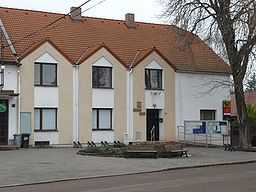Kratonohy
| Kratonohy | |||
| Village | |||
 Village Hall | |||
|
|||
| Country | Czech Republic | ||
|---|---|---|---|
| Region | Hradec Králové | ||
| District | Hradec Králové | ||
| Little District | Hradec Králové | ||
| River | Bystřice | ||
| Elevation | 234 m (768 ft) | ||
| Coordinates | 50°10′N 15°36′E / 50.167°N 15.600°E | ||
| Area | 11.34 km2 (4.38 sq mi) | ||
| Population | 584 (2008-12-31) | ||
| Density | 51 / km2 (132 / sq mi) | ||
| First documented | 1316 | ||
| Mayor | Jitka Brádlová | ||
| Postal code | 503 24 | ||
  Location in the Czech Republic
| |||
| Wikimedia Commons: Kratonohy | |||
| Website: www.kratonohy.cz | |||
Kratonohy is a small village of about 550 people in the Czech Republic, in the Hradec Králové Region, lying on a state road from Prague to Hradec Králové, 15 kilometers away from Chlumec nad Cidlinou. Kratonohy is a member of the village alliance Mikroregion Urbanická brázda.
History
Kratonohy was founded—according to a fable—by Býd, the son of count Slavomil of Kouřim at the place where he rested with his people for three days. The village was named so because of the name of the village people: kraťnožka or kraťnoha (English translation: Person with short legs). The name is quite old, believed to be originating from between the 11th to the 12th century.
Between the years of 1318 and 1323, the village was held by Tluček, Bohuněk, Licek, Mikuláš and Sezema from Kratonohy. In the 14th century, a citadel probably existed there, but the oldest written record about the citadel comes from the 16th century. In the second part of the 14th century, prominent people in the village were the Lords of Častolovice, Licek from Kratonohy and Perchta, daughter of Sezema from Kostomlaty. Perchta made a donation of some estates to St. George Monastery in Prague. From 1407–1467, there were Hroch from Dobřenice and brothers Jiří and Adam Dobřenský.
In the year 1623, Kratonohy was bought for 20,800 units of Míšeňská kopa (currency) by Alžběta Vchynská from Vchynice and Chlumec. The homestead had been held by Kinský lineage to 1644, but due to mortgages, they sold it to Asterles from Asterfeld.
At beginning of the 18th century, an elementary school was built.
In 1835, the brickkiln was commonly alluded to Kratonohy. In 1841, the polygonal barn, brewery, still-house, forester's lodge, and mill were built.
Part of the castle and homestead was restituted after the Velvet revolution.
Cultural relics
The gate of the homestead—built after the year 1720 by Giovanni Santini or his descendants, is now the property of an agricultural company, and intensively modified.
St. Jacob Church—Gothic based, baroquized in 1707-1710. It had an inwrought interior with an unusual solution: the altar was made as grotto and the rostrum as whale. The altar is a reproduction of a Spanish altar of St. James from Compostela. The wife of manor owner Jan Adam Michna from Vacínov was Spanish, thus it is believed that its interior is the work of Spanish artists. It is one of the most impressive church interiors in the Czech Republic.
Famous people from Kratonohy
- Petr Kostka, actor - lived and studied at the elementary school there
- Jaroslav Čihák, major general - born there
- Rudolf Medek, writer - taught at elementary school there before World War I
External links
| Wikimedia Commons has media related to Kratonohy. |

